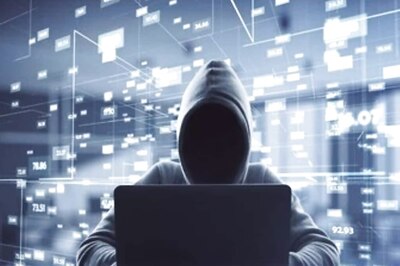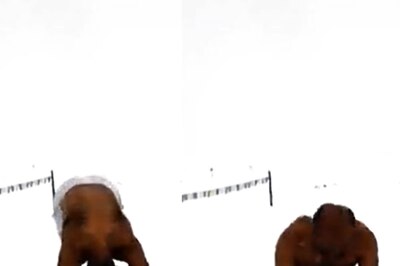
views
Indian Railways is aiming for 100% electrification to reduce carbon emissions and improve train operations efficiency in order to become the world’s largest Green Railways by 2030.
In order to meet the growing needs of new India, the railway network is guided by a holistic vision of being an eco-friendly, punctual, cost-effective, efficient and modern carrier of railway passengers and freight.
The Indian Railways is looking at ways to protect the environment, including massive electrification of the rail network, water and paper conservation, and preventing animals from being injured on rail tracks.
Earlier this year, the railway ministry released cumulative data on the electrification. According to the ministry:
• 65 RKM (route kilometres) were electrified in June 2021
• 203 RKM were electrified in July 2021
• 341 RKM were electrified in August 2021
• 562 RKM were electrified in September 2021
• 895 RKM were electrified in October 2021
• 1164 RKM were electrified in November 2021
• 1926 RKM were electrified in December 2021
• 2449 RKM were electrified in January 2022
Interestingly, the railway has planned to electrify balance Broad Gauge (BG) routes by December 2023 to achieve 100% electrification in order to capitalise on the economic benefits of the electric traction in a timely manner.
It is also believed that Head-On-Generation systems, Bio-Toilets, and LED lighting transform the train into a more environment-friendly mode of transportation while maintaining a comparable passenger comfort.
The Dedicated Freight Corridors are being developed by the railways as a low carbon green transportation network with a long-term low carbon roadmap, allowing it to adopt more energy-efficient and carbon-friendly technologies, processes, and practices.
The IR is working on two Dedicated Freight Corridor projects, which are—the Eastern Corridor (EDFC) from Ludhiana to Dankuni (1,875 km) and the Western Corridor (WDFC) from Dadri to Jawaharlal Nehru Port Trust (JNPT) (1,506 km).
Additionally, the Sonnagar-Dankuni (538 km) section of the EDFC has been planned for Public-Private Partnership (PPP) execution.
However, each year, the IR and subsidiary divisions publish the Environment Sustainability Report, which establishes a framework document describing strategy and focus points in the context of climate change, the issues at risk, and actions to address them.
This enables railways to contribute to government obligations such as the Paris Climate Agreement, the United Nations Sustainable Development Goals, and National Disaster Management Plans.
In terms of total electrification of railways, Lalit Chandra Trivedi, who is an ex-officer of the Indian Railway Service of Mechanical Engineers, and the Chairman of the Rail Division of the Indian chapter of the Institute of Mechanical Engineers, has talked to News18 and shared some insights regarding the mission.
Largest Green Railway System: Can It Be Achieved by 2030?
It’s not easy. A misconception prevails that 100% electrification will result in IR becoming carbon neutral. Since it is aiming for 100% electrification, carbon neutrality can be achieved easily as out of 20 billion KWH units that IR annually consumes, 18 billion units are accounted for by traction. (2020)
Here it needs to be understood that if an electric train is consuming electricity produced by burning coal in a thermal power plant its carbon footprints are still there only the location gets shifted to the place where the coal-based thermal power plant is located.
The railway draws the majority of its electricity from the national grid, which currently has only a 38% component of its installed capacity based on renewables. Electricity sourced from open access is still insignificant.
In fact, consumption of coal in recent months has shown an increase on account of high energy demand by the Indian economy, which is galloping after the pandemic.
So far, the IR has not met its goal of renewable energy production targets. At present, the IR’s own RE power-based installed capacity is around 2,20MW and another 3,450 MW are in the pipeline.
Steps have been taken by the IR to provide LED-based illumination, solar panels on buildings and other installations, a few wind turbines to bring down fossil fuel-based electricity requirements for non-traction purposes.
Further, the three-phase technology has made electric traction energy efficient and has enabled regenerative features, which are not possible in diesel and were not available in earlier designs of electric locomotives.
Action to create carbon sink by developing green patches and to go for green certification of buildings is also a work in progress.
HOG based train lights and air conditioning have also reduced diesel consumption.
It is therefore imperative that the goal of IR becoming carbon neutral can be achieved only if the national grid itself starts sourcing 100% electricity from renewables.
However, India is already way ahead of other countries with comparable networks in the percentage of tracks electrified. This lead will increase further as no other major railways are targeting 100% electrification.
Total electrification challenges and solutions
Out of 65,000 route km, which is planned to be electrified, 52,000 km have already been electrified as of March 2022, hence, the target of 100% electrification is well within the reach and should be achievable in around two years.
For strategic and technical reasons, however, a small percentage of trains would continue to be hauled by diesel traction.
Cost Management
At present, major benefits of electrification for IR have accrued on account of a lower energy bill. Costly diesel was a drain on the IR budget. Energy is one head of expenditure that is showing a declining trend in the IR’s budget in spite of the significant increase in the traffic.
The railways’ budget had an outlay expenditure of Rs 30,169 crore in 2019-20, which was reduced to Rs 24,075 crore in 2021-22.
Further savings are expected as electrification spreads to the remaining routes.
Green Certifications
IR’s green certification initiatives were started in 2016 after an MOU was signed with the CII. A team of independent auditors visited Railway installations (39 workshops, 7 production units, 8 loco sheds and one store’s depot) and assessed them on green rating initiatives.
The parameters for assessment included steps taken by these units in energy conservation, use of REpower, GHG reduction, water conservation, waste management material conservation, recycling.
Based on their assessment, these units were awarded platinum, gold and silver ratings. A total of 15 platinum, 9 gold and 2 silver ratings were awarded.
Read all the Latest News India and Breaking News here




















Comments
0 comment